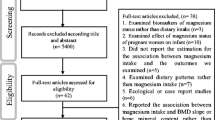Abstract
Objective To analyze the association between hip fracture incidence in 12 regional blocks within Japan and dietary intake of four key nutrients: calcium, magnesium, vitamin D, and vitamin K. Design An ecological study. Methods Using data from the 2002 national survey on the incidence of hip fracture and the National Nutritional Survey of Japan, a standardized incidence ratio of hip fracture was calculated, and the association between the standardized incidence ratio and each nutritional intake was assessed for each region using Pearson’s correlation coefficient and partial correlation analysis. Results There were significant correlations between the standardized incidence ratio by region and magnesium, vitamin D, and vitamin K in both men and women, and calcium in women. The strongest inverse correlations were found in vitamin K in both men and women (r = −0.844, P = 0.001, and r = −0.834, P = 0.001, respectively). After adjusting for calcium, magnesium, and vitamin D, the partial correlation between the standardized incidence ratio by regional block and vitamin K was strongest in both men and women (partial correlation coefficient, pcc = −0.673, P = 0.04; pcc = −0.575, P = 0.106, respectively). Conclusions The significant correlation between hip fracture incidence and vitamin K intake, and also regional variations in food patterns, suggest that increasing intake of vegetables and legumes might lead to a decrease in hip fracture incidence in the future. Further, this study suggests that a review of the dietary reference value of vitamin K from the perspective of osteoporosis would be useful.





Similar content being viewed by others
Abbreviations
- pcc:
-
Partial correlation coefficient
- BMD:
-
Bone mass density
References
Sambrook P, Cooper C. Osteoporosis. Lancet 2006;367:2010–18.
Cummings SR, Melton LJ. Epidemiology and outcomes of osteoporotic fractures. Lancet 2002;359:1761–67.
Gullberg B, Johnell O, Kanis J. World-wide projections for hip fracture. Osteoporos Int 1997;7:407–13.
Ministry of Health, Labour and Welfare, Japan. Comprehensive survey of living conditions of the people on health and wealfare (in Japanese) 2006.
Orimo H, Hosoda Y, Fujiwara S, et al. Hip fracture incidence in Japan. J Bone Miner Metab 1991;9:89–93.
Orimo H, Hashimoto T, Yoshimura N, et al. Nationwide incidence survey of femoral neck fracture in Japan, 1992. J Bone Miner Metab 1997;15:89–93.
Orimo H, Hashimoto T, Sakata K, et al. Trends in the incidence of hip fracture in Japan, 1987–1997: the third nationwide survey. J Bone Miner Metab 2000;18:126–31.
Orimo H, Sakata K. Report of the 4th nationwide survey for hip fracture (in Japanese). Nihon Iji Shinpo (Jpn Med J) 2004;4180:25–30.
NIH Consensus Development Panel on Osteoporosis Prevention D, Therapy. Osteoporosis prevention, diagnosis, and therapy. JAMA 2001;285:785–95.
Ilich JZ, Kerstetter JE. Nutrition in bone health revisited: a story beyond calcium. J Am Coll Nutr 2000;19:715–37.
Nieves J. Osteoporosis: the role of micronutrients1,2,3,4. Am J Clin Nutr 2005;81:1232S–9S.
Feskanich D, Weber P, Willett W, Rockett H, Booth S, Colditz G. Vitamin K intake and hip fractures in women: a prospective study1,2,3. Am J Clin Nutr 1999;69:74–79.
Booth S, Broe K, Gagnon D, et al. Vitamin K intake and bone mineral density in women and men 1,2,3,4. Am J Clin Nutr 2003;77:512–16.
Bugel S. Vitamin K and bone health. Proc Nutr Soc 2003;62:839–43.
Plaza SM, Lamson DW. Vitamin K2 in Bone Metabolism and Osteoporosis. Altern Med Rev 2005;10:24–35.
Schurgers LJ, Teunissen KJ, Hamulyák K, et al. Vitamin K-containing dietary supplements: comparison of synthetic vitamin K1 and natto-derived menaquinone-7. Blood 2007;109:3279–83.
Schurgers LJ, Vermeer C. Determination of phylloquinone and menaquinones in food: effect of food matrix on circulating vitamin K concentrations. Haemostasis 2000;30:298–307.
Ministry of Health, Labour and Welfare, Japan. The National Nutritional Survey in Japan, 2003.
Tucker K, Hannan M, Chen H, Cupples L, Wilson P, Kiel D. Potassium, magnesium, and fruit and vegetable intakes are associated with greater bone mineral density in elderly men and women1, 2, 3. Am J Clin Nutr 1999;69:727–36.
Bischoff-Ferrari H, Willett W, Wong J, Giovannucci E, Dietrich T, Dawson-Hughes B. Fracture prevention with vitamin D supplementation. JAMA 2005;293:2257–64.
Ministry of Internal Affairs and Communications, Japan. The household expenditure survey, 2002.
Kaneki M, Hedges S, Hosoi T, et al. Japanese fermented soybean food as the major determinant of the large geographic difference in circulating levels of vitamin K2: possible implications for hip-fracture risk. Nutrition 2001;17:315–21.
Japanese Recommended Dietary Allowances (in Japanese). Daiichi Shuppan, Tokyo, 1999.
Prentice A, Branca F, Decsi T, et al. Energy and nutrient dietary reference values for children in Europe: methodological approaches and current nutritional recommendations. Br J Nutr 2004;92(Suppl 2):S83–146.
Acknowledgements
The authors thank Ruth Bonita for comments on an earlier draft of this paper.
Author information
Authors and Affiliations
Corresponding author
Rights and permissions
About this article
Cite this article
Yaegashi, Y., Onoda, T., Tanno, K. et al. Association of hip fracture incidence and intake of calcium, magnesium, vitamin D, and vitamin K. Eur J Epidemiol 23, 219–225 (2008). https://doi.org/10.1007/s10654-008-9225-7
Received:
Accepted:
Published:
Issue Date:
DOI: https://doi.org/10.1007/s10654-008-9225-7




